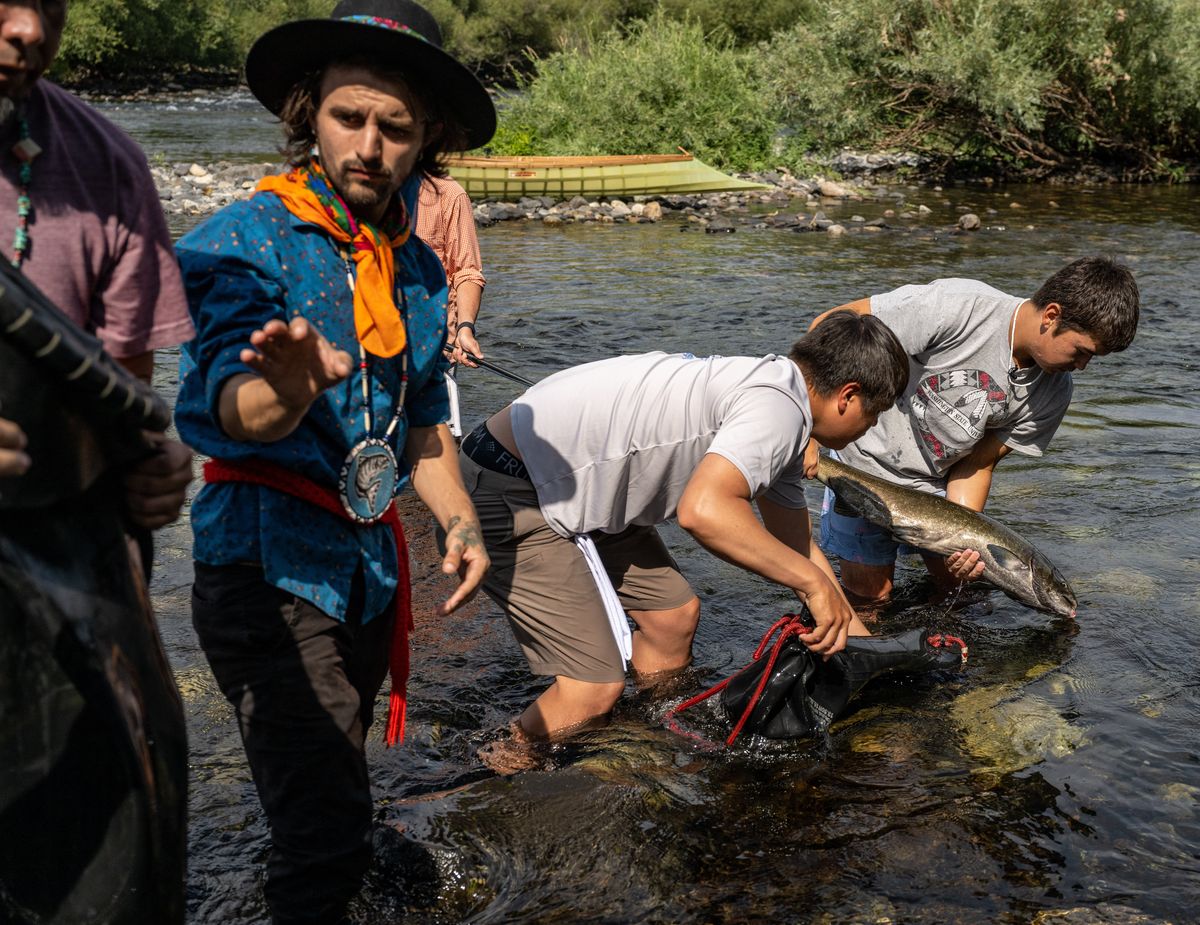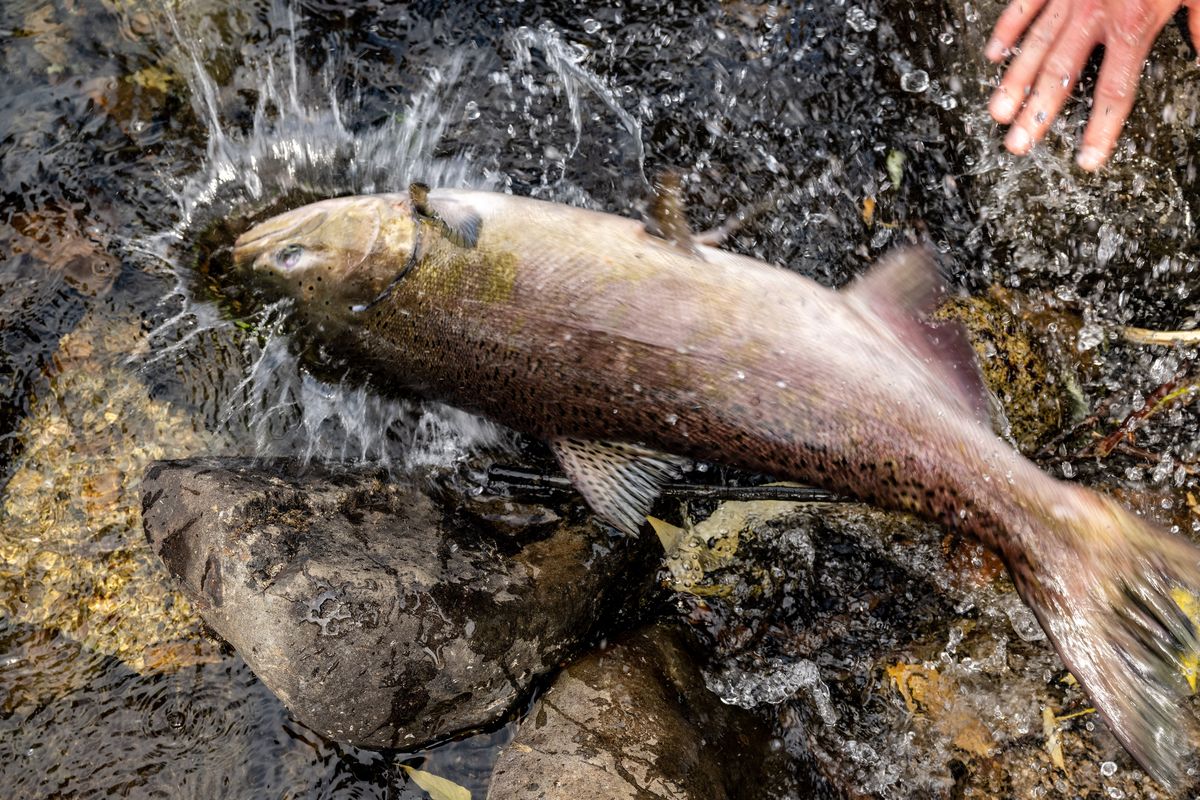Spokane Tribe releases 146 Chinook salmon into Spokane River, highlighting increasing respect given to indigenous knowledge

Imagine the Spokane River so full of salmon you can’t see the bottom, Warren Seyler told more than 200 assembled fishery professionals Wednesday morning.
The big ocean-going fish returning to their native streams in the hundreds of thousands, providing sustenance for people, animals and plants. As he spoke, historic photos and accounts from tribal elders flashed across the Spokane Convention Center screen.
“Today the Spokane Tribe continues to try and find ways to get them back,” said Seyler, a Spokane tribal member and an expert on tribal history. He was addressing attendees at the 52nd annual meeting of the American Fisheries Society.
Hours after his address, that fantasy inched toward reality when 146 adult chinook salmon were released into the Spokane River at Sandifur Bridge. Hundreds watched. John Matt Jr. had the honor of releasing the first of the chinook. Matt, who lives on the Spokane reservation said it felt “really good. I cried.”
The release was part of the Spokane Tribe and other Upper Columbia basin tribes’ ongoing efforts to reintroduce sustainable salmon into the farthest reaches of the Columbia River basin.
It illustrates, however, the increasing prominence given to Indigenous knowledge and perspectives in fishery and natural resource management. Roughly 1,500 fish and water scientists, educators and policymakers from around the world are in Spokane for the weeklong conference. That conference opened with an address from Spokane Tribal chairwoman Carol Evans and prominently featured Wednesday’s talk from Seyler and the accompanying fish release. Even 10 years ago this wouldn’t have happened, Seyler said.

“We might have set a table up,” he said. “ ‘Look, here is the Indian table.’ ”
That’s no longer the case. At Wednesday’s release, scientist from all over the U.S. and world saw how regional tribes have led the way on salmon reintroduction, even as headlines and money get siphoned up by more controversial efforts such as removing four dams on the Snake River. That gradual acceptance, and honoring, of native knowledge has happened slowly, although Seyler said it picked up in the early 1990s. That’s when tribes started getting money from the Northwest Power Act, passed by Congress in 1980. The act provided money to mitigate some of the damage done to fish and wildlife by hydroelectric dams in the Columbia River Basin.
That money, paired with key legal changes, allowed tribes to send their members to school for fish and wildlife biology, hire lawyers and generally advocate for their rights and interests.
“Those were the building blocks,” Seyler said.
Meanwhile, scientific “discoveries” continued to validate Indigenous knowledge – Kennewick Man being a prime example.
In 1996, an ancient skeleton was found on the shores of the Columbia River. At the time, scientists said the skeleton was only distantly related to Native American tribes in the region, despite the claims of the Umatilla Tribe and others that Kennewick Man was one of theirs. In 2015, more advanced DNA testing proved the tribes right.
That was the larger context for Wednesday’s release, Seyler said.
While the release was billed as a cultural one, meaning none of the fish will be tracked, Seyler and others said it will build awareness and hope for native and nonnative peoples alike.
“In the not too distant future, salmon are going to be able to make it up here on their own,” Conor Giorgi, anadromous program manager at the Spokane Tribe of Indians told the crowd Wednesday. “But today they need your help.”
Attendees lined up and passed the hatchery raised fish (which were in large rubber bootlike containers) hand-over-hand down the bank and into the Spokane River just upstream of the Sandifur Bridge.
Since 2015, the Upper Columbia United Tribes – which include the Coeur d’Alene Tribe of Indians, Confederated Tribes of the Colville Reservation, Kalispel Tribe of Indians, Kootenai Tribe of Idaho and the Spokane Tribe of Indians – have worked to reintroduce salmon into the blocked regions of the Columbia River, without dam removal.
In 2019, Phase 1 of that work wrapped and found, among other things, that there are 711 miles of possible habitat for spring chinook and 1,610 miles for summer steelhead.
Now the tribes are in Phase 2. In March, tribal managers introduced tagged salmon in the Columbia system to test the habitat and survivability estimates developed in Phase 1. Meanwhile, some smolts released during Phase 1 have started to return.
Phase 2 will examine the best method for getting fish up and over Grand Coulee and Chief Joseph dams, which were built without fish passage.
While fishery managers have planned on Phase 2 taking 21 years, Giorgi said with “adequate funding” the project could be completed sooner.
For now, 46 adult chinook are in a part of the Spokane River that hasn’t seen salmon since 1911 when Little Falls Dam was built.
“All of our ancestors have wanted this,” said Jeannette Finley, deputy director for the Colville Fish and Wildlife Department. “It’s an emotional feeling.”